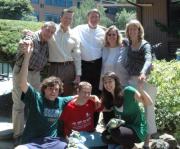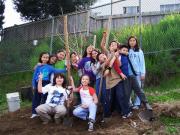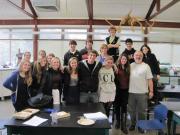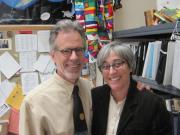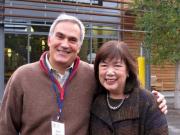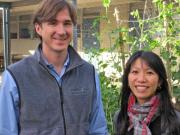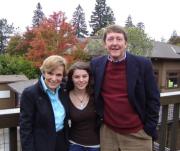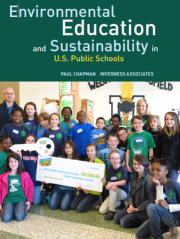Globally Green: The East-West Center and ASEAN
Leading Green: Shaping Sustainable Schools and Communities
After speaking with a group of environmental educators in January at the Punahou School, I received an invitation to help plan an innovative exchange program that would weave together two central themes articulated by the National Association of Independent Schools: global and environmental sustainability. Namji Steinemann, Director of the AsiaPacificEd Program and Associate Director of the Education Program for the East-West Center in Honolulu, called to describe an opportunity to bring youth leaders from the Asia Pacific region to the United States for a three week program of cross-cultural, leadership, and environmental education. Long an advocate of global education, and more recently focused on environmental sustainability issues, I quickly said yes! The first exchange in a three-year program took place this fall and heralds an important opportunity to prepare young leaders for the coming global challenges their generation will face.
The exchange leader, Namji Steinemann, has brought over twenty years’ experience to shaping this exciting new program. The daughter of Korean immigrants parents, she was raised in North Carolina, received her B.A. from East Carolina University, served as a Peace Corps teacher in Thailand, and has lived and traveled abroad extensively. Beginning her career with the Asia Society, she served as vice president of education program and oversaw the National Commission on Asia in the Schools as its executive director prior to joining the East-West Center in 2001. The East-West Center (EWC) itself was established in 1960 by the U.S. Congress to “promote better relations and understanding among the people and nations of the United States, Asia, and the Pacific through cooperative study, research, and dialogue.” The Asia Pacific Education Program, which she directs and which has sponsored the exchange, provides global education and exchange opportunities for teachers and high school students in the United States and in the Asia Pacific region. The exchange has been made possible through funding from the Bureau for Educational and Cultural Affairs (ECA) at the U.S. State Department and is sponsored by the Southeast Asia Youth Leadership Program (SEAYLP).
In early November Leading Green: Shaping Sustainable Schools and Communities brought its first cohort of 25 students and 6 educators from Brunei, Laos, Malaysia, Singapore, and Vietnam to the United States. The U.S. Embassies in sponsoring nations selected student leaders after an extensive application and review process. The Youth Leadership Program seeks to “promote mutual understanding between participants and diverse Americans by learning how to meet global and local challenges” and to “prepare youth leaders to become responsible citizens and contributing members of their communities by applying democratic principles.” With Namji Steinemann’s leadership, this version of the SEAYLP exchange is focused on “global sustainability and developing youth as environmental leaders…through the lens of ‘green schools’ as part of sustainable communities.” Participants explored several essential questions: What is the role of the environment in community? What are different ways communities can come together to improve or protect their environment? What are some global environmental challenges today, and what challenges are anticipated in the future?
The exchange began with an orientation at the East-West Center in Hawaii, where students attended a panel discussion called “Perspectives on Environmental Leadership” with some of the state’s foremost environmental leaders. The group learned about Hawaiian culture and ecology through a number of field trips and community service opportunities. And then the delegation then headed to the mainland during the presidential election week to visit the San Francisco Bay Area and Washington, DC.
In the Bay Area, the ASEAN students and faculty were hosted by three of the area’s leading green schools: Castilleja School, Head-Royce School, and Berkeley High School. Students participated in a week-long homestay to experience cross-cultural exchange and dialogue. The ASEAN students wrote introductory letters to their homestay families, frequently mentioning their desire to learn about American pop culture, food, and music! Each school crafted several days of class visits, meetings and activities, to help the students understand how their host schools became focused on environmental sustainability, how they became more green, and on the essential question of how students and teachers can “create a green environment at school or in their home community.” Students in the East Bay spent several days touring local green schools, including Berkeley’s Rosa Parks Elementary School and Martin Luther King Jr. Middle Schools, home of the Edible Schoolyard, as well as UC Berkeley’s student-led Building Sustainability at Cal and the city’s Brower Center, a LEED Platinum building devoted to supporting environmental groups. Castilleja students studied nearby Sacred Heart Preparatory School green initiatives and Stanford’s acclaimed sustainability program. The delegation also visited a variety of informal environmental education organizations to learn about urban farming, municipal recycling, waste and water management.
Flying across country, the ASEAN delegation spent a week in Washington D.C. hosted by three outstanding, green independent schools: Maret School, Potomac School, and St. Stephen’s & St. Agnes School. In addition to the traditional homestays and school visits, the delegation participated in the Students for Sustainability (S4S) Conference hosted by St. Stephen’s & St. Agnes. Visits to the Capital’s historic sites and reflection on the principles of participatory democracy provided the backdrop for welcoming receptions at the National Association of Independent Schools in their new LEED Platinum offices, and at the State Department.
Throughout the exchange the student leaders crafted their own Green Action Plans, which they will work to implement when they return to their home countries. Five additional exchanges are planned over the next three years. As Namji Steinemann observes, “The green school concept has taken hold in the ASEAN region, and there is a strong commitment both at the national and the local level to 'greening' the region, including creating green schools.” By inspiring young leaders from Southeast Asia and the United States, the East-West Center is making an important contribution to “shaping sustainable schools and communities.” We will be the better for their efforts.

